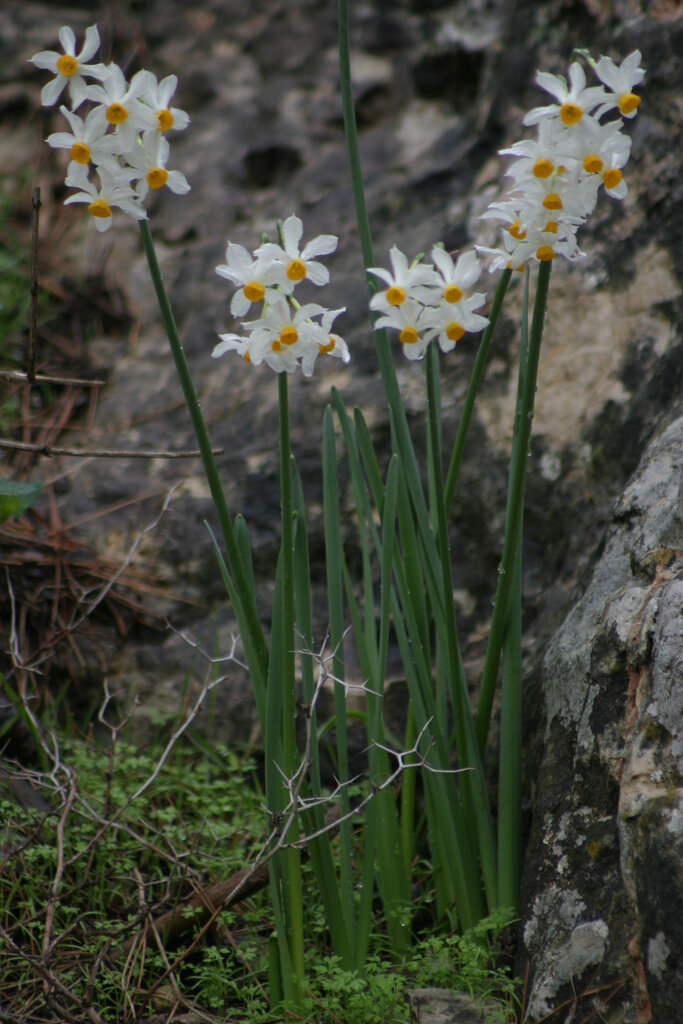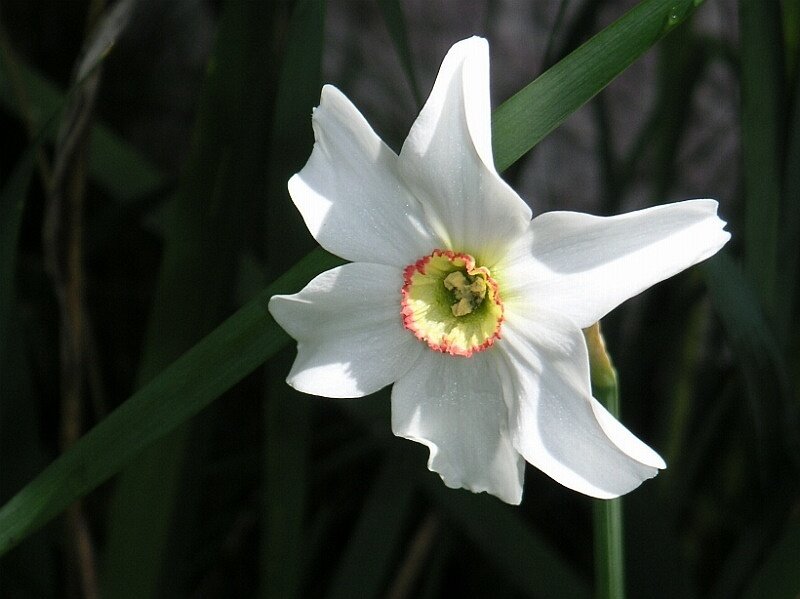Narcissus
Narcissus poeticus, Narcissus tazetta
Youth - Beauty - Awakening Desire - Self-Love
Named for the gorgeous Boeotian youth who fell in love with his own reflection, Narcissus is a perennial bulb in the amaryllis and daffodil family (Amaryllidaceae) characterized by six white tepals around a golden corona. In Greece, this is the Narcissus poeticus or N. tazetta. The flower blooms in late winter and early spring, reminding us of its connection to youthfulness and the awakening of desire after the numbness of winter. It prefers damp meadows and the banks of streams and rivers, where it can lean close to watch its reflection in the waters. Although all parts of the flower are toxic to ingest, the Narcissus can be used in ceremony to awaken desire and bring awareness to our capacity for self-love. Keep reading below to learn more about the Narcissus.
Index
The Narcissus in the Wild & Garden
LATIN BINOMIAL
Narcissus poeticus, Narcissus tazetta
PLANT FAMILY
Amaryllidaceae
COMMON ENGLISH NAMES
Narcissus, Paperwhite, rarely referred to as Asphodel
COMMON GREEK NAMES
Νάρκισσος
CHARACTERISTICS
Springtime, perennial bulb in the amaryllis and daffodil family
NATIVE HABITAT
Mediterranean
PREFERRED CLIMATE & CONDITIONS
Full sun to part shade in moist soils. Hardy in Zones 3-9. Growing in the ground, can handle temperatures as low as -5°C (23°F). Typically found near the banks of streams or in damp meadows.
N. poeticus
TYPICAL HEIGHT AND SPREAD
20-60 centimeters (7-23 inches) in height; up to 10 centimeters (3 inches) in spread
BLOOM COLOR AND CHARACTER
N. tazetta: six white tepals around a golden corona; each stem can have anywhere from 4 to 12 or more blossoms; blooms in early spring (can be found between February and May in Greece)
N. poeticus: six white tepals around a red-rimmed yellow corona; typically one flower per stem; blooms in mid to late spring (can be found between late March and early June in Greece)
COMMON DISEASES
Bulb scale mite; basal rot
NOTES ON PROPAGATION, HARVEST, AND PRESERVATION
Propagate: Bulb division in summer (after all foliage has yellowed and the bulb has gone dormant) or in early fall.
Grow: Grow in clumps or “sweeping drifts” in tall grass, along borders, in beds, or under deciduous trees. Prefers moisture and can tolerate damp soils in winter and spring. Narcissus tazetta (often called “paperwhite”) can also be “forced” to bloom indoors in winter.
Prune: After flowering, prune flower stalks at their base to prevent seed production and encourage more blooms the following year. Be sure to leave the foliage to continue photosynthesis (green leaves are still photosynthesizing, so be sure to wait until the leaves have yellowed completely, indicating that the bulb is dormant). After the leaves turn yellow in summer, remove the foliage at the base.
Harvest: Cut stems of flowers just after blooming, when their perfume is at its height.
The Narcissus in Greek Mythology
The Youth Narcissus
Narcissus was the beautiful son of the nymph Liriope and the rivergod Kifisos, hailing from the region of Boeotia. Despite his incredible beauty, Narcissus was uninterested in love and numb to the advances of anyone who wanted him, male or female. He would harshly dismiss any possible lover.
One particular suitor that Narcissus had rejected, Ameinias, had been so devastated by Narcissus's rejection that he took his own life, calling out to the gods as he died that Narcissus should be cursed to know the pain of unrequited love. The goddess Nemesis heard Ameinias' plea and obliged him, so when Narcissus knelt to take a drink from a crystal clear pool, he had the ill fortune of falling in love with his own reflection.
Consumed by desire for himself, Narcissus was unable to pull himself away. He ached and pined and burned in unrequited love for himself, ignoring his need for food or rest. Slowly, his body wasted away beside the water. Some say he eventually fell into the pool and drowned, others say that his body disintegrated and transformed into a white flower with a golden center - the Narcissus flower.
It is interesting to note that the word "narcissus” shares the same root as the Greek word “narcotic”- narke, which means “to numb.” And while this probably refers to the numbing nature of the plant itself, it is also symbolic of Narcissus’s numbness to his own capacity for sexual desire. He rejected his human need for physical connection, and by wishing only to live in youthful solitude, he denied a core aspect of his humanity: the need to want and be wanted.
Because Narcissus failed to see this essential aspect of his own nature, he was cursed for his arrogance. In symbolic Greek fashion, he was doomed to stare into a mirrored surface - a tool that is supposed to reflect reality - as punishment for his ignorance. His eyes were wide open and staring, but he didn't know or recognize himself, and so he couldn't see that he was the source of love that he craved.
In the end, his body and human identity disintegrated and only a flower remained.
To hear more about the story of Narcissus and the conifer nymph, Echo, who loved him, listen here to the first episode of A Temple Wild Podcast.
A Temple Wild Podcast
In this podcast episode, we discuss the myth of Narcissus, that beautiful youth who fell in love with his own reflection, and the nymph Echo, whose obsession with Narcissus led to her own dissolution.
I adore this myth, not because Narcissus suffers for his ego or pride, but because I believe there is a deeper message in this story - a message about numbness, obsession, and human desire - a message I think that most people miss...
Persephone
Some stories say that the goddess Persephone was picking Narcissus flowers when the god Hades abducted her to the underworld.
In one version, Hades conspired with Gaia, the great Earth goddess, to create a field of Narcissus flowers in order to lure Persephone away from the watchful eye of her retinue, so that he could then steal her to his subterranean realm. Intoxicated by their fragrance and drawn to their beautiful white petals and golden corona, she wandered away from her company to pick the flowers. Just then, catching her finally alone, Hades arrived, driving a chariot of four black horses, and plucked the goddess from the meadow, dragging her down to the depths without leaving a trace.
I see this as symbolic of Persephone's own numbness to her sexual nature: she is preoccupied with youthful freedom and doesn't notice the consuming force of human desire—in the form of Hades—sneaking up on her until it is too late.
Though not typically thought of as a chthonic plant, it seems to me that Narcissus also indicates the location of an entrance to the Underworld. To hear more about Persephone’s descent and her connection to the Narcissus, see Persephone and the Descent to Hades and Plants of the Underworld.
Back to top
The Narcissus in Ceremony
Youth - Beauty - Awakening Desire - self-love
The Narcissus flower grows in early spring, reminding us of youthfulness and the beauty of new growth after a long, cold winter. Its heady fragrance is sensuous, almost like an aphrodisiac, awakening desire and thawing our hearts to love.
Because of its association with the beautiful youth Narcissus, the flower can be a reminder to let go of our numbness, to awaken to our desires, and to stay open to the power of human connection. This does not mean just sexual desire, but could also apply to the desire to be truly seen and understood by another person. Especially in these difficult times, instead of rejecting others or turning a cold heart against the world, the flower invites us to stay soft and wanting. We are encouraged to reach out for one another - and the earth - even when our fierce independence may want to keep us numb and alone.
The Narcissus also encourages us to look upon ourselves with love. And while the myth may seem like a warning against loving ourselves too much, it was actually Narcissus’s inability to recognize himself as the source of love that he craved that led to his demise. The myth teaches us to regard our own reflection with honesty, humility, and tenderness - not obsession or loathing. In a society that is bent on convincing us of our worthlessness and lack, to look upon ourselves with acceptance - especially our bodies - is a radical act.
By breathing in the scent of the Narcissus flower, growing the flower in our garden, or adorning our altars with its intoxicating fragrance, we awaken our senses and celebrate the amazing capacity of our bodies to feel.
Parts Used
Cut flowers or whole blooming bulbs.
Safety
Toxic when ingested; can cause contact dermatitis for some people. Avoid eating, burning, smoking, or applying directly to the skin.
Elemental Correspondence
Seasonal Celebrations
Air Season: Late Winter through Springwater Season: Late Spring
Altar
In early spring, adorn your altar with cut flowers in vases, with strewn blossoms, or with the bulb, grown in a container. Include a shallow bowl of water, to connect with the watery nature of Narcissus, as well as a small mirror, to regard your own reflection with clarity and adoration.
Ceremony
Include Narcissus in any ceremonies for celebrating youth, beauty, and the awakening of desire. This can be especially powerful for rites of passage for youth transitioning from childhood to young adulthood and coming into a deeper understanding of their sexuality. You could also include the flower in any ceremonies for reawakening the senses or encouraging self-love, especially after a long period of numbness, depression, or disconnection from the world.
Devotion
Whether sitting before your altar or kneeling before the living flower in the wild, inhale the scent of the Narcissus and then, while gazing into a mirror or imagining your own reflection, read the following devotion. You can also read this affirmation to a friend, a lover, or any non-human kin you’d like to shower with adoration and love.
Sweet One, I see you.
You are a source of love, a fount of beauty.
I see you. I see you. I see you.
The Narcissus in the Kitchen & Apothecary
Although Hippocrates and Dioscorides both mention Narcissus oil as a cure for uterine tumors - and Pliny the Elder writes of using its roots topically - all narcissi are toxic when ingested.
Today they are not typically used by herbalists as medicine. The flowers are more commonly used for floral arrangements, garden adornment, and as a popular ingredient in perfume.
In springtime, the fragrant Narcissus tazetta is sold in bunches at local farmers markets and garden shops all around Greece. In the USA, it is popular to “force” paperwhites (N. tazetta) to bloom indoors during winter for holiday festivities and aromatic decoration.
Safety and Drug Interactions
Toxic when ingested. Avoid eating, burning, smoking, or applying directly to the skin.




![Narcise-Golica1-Sl-Ziga [CC BY-SA 3.0 (http- creativecommons.org licenses by-sa 3.0 )].jpg](https://images.squarespace-cdn.com/content/v1/5e022435901d26328f573f43/1577534893146-VS2DQMT2JKWXH5JZX2KH/Narcise-Golica1-Sl-Ziga+%5BCC+BY-SA+3.0+%28http-+creativecommons.org+licenses+by-sa+3.0+%29%5D.jpg)









![Narcissus tazetta, Roemer-Daiju Azuma [CC BY-SA 2.5]](https://images.squarespace-cdn.com/content/v1/5e022435901d26328f573f43/1577536246828-J5WLBKY2ZKO8364Y6UF7/Narcissus_tazetta_L._var_chinensis_Roemer-Daiju%2BAzuma%2B%255BCC%2BBY-SA%2B2.5%2B%2528https-%2Bcreativecommons.org%2Blicenses%2Bby-sa%2B2.5%2529%255D.jpg)









